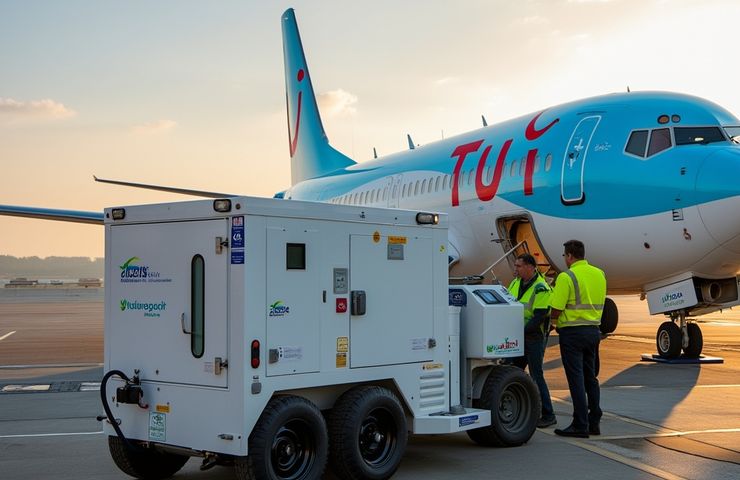
Exeter Airport Powers First UK Hydrogen Aircraft Turnaround with Fuel Cell Technology
May 2, 2025Exeter Airport just pulled off something big for the future of flying: the UK’s first ever hydrogen-powered commercial aircraft turnaround—and yes, this was the real deal, not a lab test or flashy demo. By using fuel cell ground support equipment (GSE) to prep a plane between flights, they took a major step toward cleaner, zero-emission airport operations. Think hydrogen tugs, GPUs, and mobile refueling all working in sync, as part of the regular hustle on the tarmac.
Hydrogen Hits the Tarmac: What Went Down?
This milestone happened at Exeter Airport in Devon—an area known for its strong ties to aerospace and £2 billion aviation economy. Teaming up with Fuel Cell Systems Ltd, green hydrogen supplier Protium, Cranfield University, and airline TUI, the airport powered up hydrogen-fueled baggage and pushback tugs plus a hydrogen-powered ground power unit (GPU) to service a working Boeing 737-800.
Fuel came from the HyQube 350—a mobile refueling system built by Fuel Cell Systems. Running at 350 bar, it delivered clean hydrogen created through electrolysis, using nothing but renewable energy from Protium’s supply chain. No diesel. No carbon. Just green power doing its thing.
How It Works and Why It Matters
The GSE ran on proton exchange membrane (PEM) fuel cells, a zero-emission technology that turns hydrogen into electricity without combustion. While PEM fuel cells have been around in cars and even space gear, getting them onto the tarmac has been slow thanks to hurdles like fuel storage and logistics. But clearly, that’s starting to change.
To put things in perspective, Cranfield University reports Exeter’s GSE fleet burns through roughly 78,000 liters of diesel a year. Swapping that for hydrogen could save around 200 tonnes of CO2 annually. That’s massive—for a small regional airport, it’s like erasing the emissions of dozens of cars overnight.
It’s Not Just a One-Off
Don’t write this off as a publicity stunt. This trial was the real deal: working with actual airline equipment, sticking to live schedules, and proving hydrogen can pull its weight in day-to-day ops. While the exact date is under wraps, insiders say it happened recently—ahead of the big hydrogen conversations coming to Canada’s Clean Fuel Conference in May 2025.
What really sets this trial apart is the team effort. Exeter Airport, run by Regional & City Airports, handled the game plan. Fuel Cell Systems brought the tech. Protium supplied the green hydrogen. TUI provided the aircraft, and Cranfield University tracked emissions. It’s a textbook example of how collaboration drives innovation—and why that matters for policy and ESG benchmarks.
Bigger Than Exeter
Look around, and it’s clear the hydrogen transition isn’t all smooth sailing. In early 2024, Nikola Corp filed for bankruptcy, showing just how tricky large-scale hydrogen infrastructure can be. On the other end, Dow Chemical’s $9 billion blue hydrogen venture in Alberta is tied up in red tape and delays.
That’s what makes Exeter’s success special—it’s punchy, real-world progress. Infrastructure is the choke point, not the idea. And when small, agile airports like Exeter show it can be done, they add real momentum. The UK’s Jet Zero Strategy is pushing for more green hydrogen and sustainable fuel use by 2030, but it’s clear: hydrogen isn’t a sideshow—it’s key where batteries fall short.
Policy Winds Are Shifting
Governments are talking up clean aviation, but funding is still hit-or-miss. The UK’s Department for Transport has been a research backer, but substantial capital support hasn’t quite followed. Meanwhile, Canada’s throwing $1.5 billion behind blue hydrogen through its Clean Fuels Fund—though that’s not without environmental concerns around carbon capture and methane use.
What projects like Exeter’s need is more than cheerleading—they need policies that plug the gap between climate targets and tarmac realities. If airports can prove it works, they could become candidates for deeper retrofitting, using international subsidies or even carbon credits to expand scalable, zero-emission technology.
The Road (Or Runway) Ahead
Wrapping up a hydrogen-fueled aircraft turnaround on a working airfield is no small feat. And while we’re still a ways off from commercial passenger planes running on hydrogen, ground ops offer a sweet spot—low risk, high reward. Portable solutions like the HyQube 350 mean airports don’t need major overhauls to join the movement. Size doesn’t matter—ambition does.
The bottom line? This isn’t just a proof of concept—it’s proof of capability. By showing what’s truly doable, Exeter Airport has helped kick-start the normalisation of hydrogen fuel cells in aviation. For regulators, investors, and the whole clean transport ecosystem, the signal is clear: the hydrogen revolution is already rolling—and the race is on.



 With over 15 years of reporting hydrogen news, we are your premier source for the latest updates and insights in hydrogen and renewable energy.
With over 15 years of reporting hydrogen news, we are your premier source for the latest updates and insights in hydrogen and renewable energy.